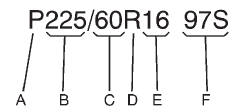Tire Designations
Tire Size
The following is an example of a typical passenger vehicle tire size.

(A) Passenger (P–Metric) Tire:
The United States version of a metric tire sizing system.
The letter P as the first character in the tire size means a passenger vehicle tire engineered to standards set by the U.S. Tire and Rim Association.
(B) Tire Width: The three–digit number indicates the tire section width in millimeters from sidewall to sidewall.
(C) Aspect Ratio: A two–digit number that indicates the tire height–to–width measurements.
For example, if the tire size aspect ratio is 60, as shown in item C of the illustration, it would mean that the tire's sidewall is 60 percent as high as it is wide.
(D) Construction Code:
A letter code is used to indicate the type of ply construction in the tire. The letter R means radial ply construction; the letter D means diagonal or bias ply construction; and the letter B means belted–bias ply construction.
(E) Rim Diameter: Diameter of the wheel in inches.
(F) Service Description: These characters represent the load index and speed rating of the tire. The load index represents the load carrying capacity a tire is certified to carry. The speed rating is the maximum speed a tire is certified to carry a load.
See also:
Hitches
The correct hitch equipment helps maintain combination control. Many trailers
can be towed with a weight carrying hitch which simply features a coupler latched
to the hitch ball, or a tow eye latc ...
Reporting Safety Defects
to the United States
Government
If you believe that your vehicle
has a defect which could cause
a crash or could cause injury or
death, you should immediately
inform the National Highway
Traffic Safety Administration
(NH ...
Traction Control System (TCS)/StabiliTrak® Light
The TCS/StabiliTrak light comes on briefly when the engine is started.
If the light does not come on or stays on, have the vehicle serviced by the dealer.
If the system is working normally, the i ...






